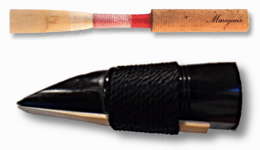Single vs. Double Reed
Clarinet and saxophone both have single reeds, that is, the reed is from a sheet of flattened reed, being fixed upon the mouthpiece. Very much in contrast to this a double reed instrument - like oboe or bassoon - uses double reeds and does not need an extra mouthpiece:
-

- Double reed (oboe) and single reed (on clarinet mouthpiece)
With double reeds you fold a much thinner reed of the same material (Arundo Donax as well) that is first flattened and then folded - in the end the part where you have folded it is cut. This results in something that looks like a flattened straw. Both sides of the flattened straw are now worked on with delicate instruments, usually knifes sharp as a razor, with the same precision as single reeds (but on both sides and symmetrically, of course).
While the single reed needs a mouthpiece to create a tone, the double reed can in itself create the tone, because it has the tip opening between the two flattened parts of the reed that make the reed swing.
Needless to say that the process to build a double reed is more complex, more prone to mistakes than making a single reed. This results in higher prices - or longer hours, if you do it yourself, as many oboe and bassoon players do. If you ever were angry about your reeds, the trouble you had with them, the money you spent, then do look at bassoonists, smile and be happy!